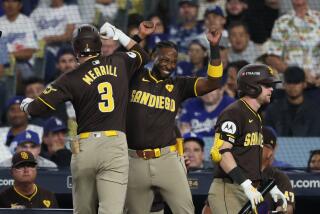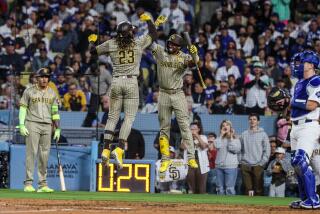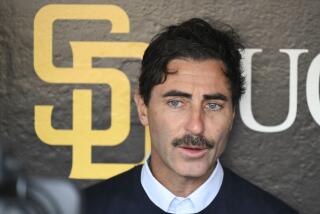Alomar Leaves San Diego in His Past, AL Pitchers in His Dust
- Share via
ANAHEIM — Robbie, we hardly knew ye.
So trades are part of baseball and hindsight is 20-20 and Tony Fernandez is one of the game’s fine shortstops and Fred McGriff is leading the National League in home runs and runs batted in.
Still, it’s hard to overlook how Roberto Alomar is body-slamming the American League, and how often the term “Hall of Fame” comes up when his name does.
Having just turned 24, Alomar is being mentioned with the likes of Kirby Puckett and Ryne Sandberg. Last year--after the Great Alomar Exodus from San Diego--he adjusted to the AL with ease, hitting .295 with 53 stolen bases and 188 hits, including 41 doubles and 11 triples.
This year he ranks with the league leaders in virtually every offensive department but home runs. Despite an 0-for-9 slump through Friday, he still led the league in batting (.366), hits (45) and runs (26). He is among the best with 23 RBIs and eight stolen bases, has an on-base percentage of .435 and a slugging percentage above .500. After going 0 for 4 Friday against the Angels he was still batting .500 with runners in scoring position.
All that has been accomplished in the second spot in the order, where he is often asked to advance leadoff man Devon White.
And his defense has been stellar, as reflected by his 1991 Gold Glove.
When Joe McIlvaine took over as general manager of the Padres and traded Alomar and slugger Joe Carter to Toronto for Fernandez and McGriff in December, 1990, the Padres got what they expected--one of the game’s best shortstops and a left-handed power hitter.
Toronto got what may be the cornerstone of a continuing string of AL East titles. Despite outstanding seasons last year by veterans like Carter, White and Tom Henke, Alomar was named the Blue Jays’ most valuable player.
“You want to talk about Alomar?” Carter asked with mock anger in the Blue Jays locker room here. “Everybody wants to talk about Alomar the last two years. Why? Robbie Alomar can’t play!”
After dissolving in laughter, Carter got serious. “He’s a lot better than he was in San Diego,” he continued. “He adjusted to this league so quickly and so fast, he improved in every phase of the game. At San Diego he made a lot of young mistakes, but you could see the talent was there. The only thing he’s not doing is hitting home runs, but he’s probably the best all-around ballplayer in the game. A lot of people feel that way.”
Carter then critiqued the trade: “Tony Fernandez is a great shortstop. But for Alomar? That’s tough, to give away a franchise player like that. I never would’ve done it.”
Say it ain’t so, Joe.
Angels Manager Buck Rodgers, who managed Montreal when Alomar broke in with the Padres as a 20-year-old in 1988, said, “He’s really come offensively. He was a good second baseman by the tail-end of his last year in San Diego. He’s working on being one of the premier players in this game. He’s just got to put some good years together.”
Toronto Manager Cito Gaston, who only knew Alomar from scouting reports before the player joined the Blue Jays last year, said there’s little Alomar is doing this season that he wasn’t already doing last year.
“He probably knows the pitchers better,” Gaston said. “Last year he was everything the scouts told us. This year he’s just a little better. He always loves to play.”
Trying to assess what Alomar has to do to improve, Gaston was hard-pressed. “Just stay healthy and keep putting up good numbers,” he finally answered. “He’s got a good chance to be a Hall of Famer if he doesn’t get hurt. He’s one of the best players in the league--he’s definitely right in that category.”
Alomar isn’t ready for a one-way ticket to Cooperstown yet.
“I’m just going out and do the job,” he said. “I just hit the ball and it’s going to the right spot. When you’re hot, you’re hot.
“Can I keep this up? How can you answer that? I’ll just continue to do my job. I’m not looking at numbers. I just want to help the team win. Numbers are not everything.”
There is one statistic Alomar especially likes: The switch-hitter is batting .419 right-handed, with more than half his RBIs coming in half the at-bats he has left-handed.
And he’s not doing too badly from the left side, batting .338.
“I knew I can hit left-handed good for average--right-handed is my power side. So when I’m hitting great right-handed I’m gonna have a good average,” he said.
Alomar still has a home in Del Mar and said he continues to like the San Diego area. But there is life after the Padres.
Alomar was traded after an emotionally trying season in which he was asked--unhappily--to play some shortstop, and his father, Sandy Alomar, was fired as a Padres coach. The senior Alomar didn’t get along with Greg Riddoch, who had taken over as manager of the team from Jack McKeon in mid-season.
Catcher Sandy Alomar Jr., Roberto’s older brother, had been traded to Cleveland the winter before.
Scott Boras, who was Alomar’s agent at the time, said, “I think there were a number of factors” in the trade.
“McKeon asked Robbie to play shortstop in Houston and he said fine. My advice to Robbie was he is a Hall of Fame second baseman, he’s too quality of a player to be moved around. I said, ‘If you’re most comfortable at second base let it be known.’
“Riddoch had made the decision to get rid of (Sandy Alomar). Robbie was upset and he let it be known. So McIlvaine came into this hornet’s nest. He wanted a shortstop and he wanted a left-handed first baseman. I think he made the deal thinking Robbie was a good player but Fernandez was a better player.
“(Toronto vice president) Pat Gillick had scouted Robbie from his younger days and he knew, like I knew (how good he was); he really coveted Robbie and that’s why the deal got done. Credit Toronto--I think he’s the best player in the American League right now as far as defense, offense and run production.”
Amid the family tumult, Alomar’s production had fallen slightly, from .295 the previous year to .287, and from 42 stolen bases to 24. McIlvaine, coming over from the Mets front office, made the blockbuster trade.
Rodgers said, “It was a quality-for-quality trade. When you think about it, it was probably one of the most quality trades ever.”
Alomar said: “(The Padres) needed a shortstop, more than a second baseman.
“I don’t have nothing against the team. . . . Life goes on. It’s not the end of the world because they trade me. I’m a baseball player, I’m ready to play anywhere.”
But it’s nice to be playing for a perennial playoff contender.
“I like San Diego, it’s nice weather, nice people, but I don’t miss the team,” he said. “I’m happy (in Toronto), it’s a winning ballclub and the fans treat me nice.”
For the moment Alomar’s main concerns are staying healthy and continuing to see the ball well. “I’m just happy to be in the lineup,” he said. “I’m the hot hitter right now so (pitchers) are being careful. They’re throwing some pretty tough pitches. But I been seeing the ball good.”
You have to wonder what the Padres see when they look at the box scores.
More to Read
Go beyond the scoreboard
Get the latest on L.A.'s teams in the daily Sports Report newsletter.
You may occasionally receive promotional content from the Los Angeles Times.






